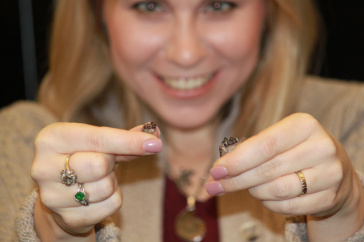The University of New Hampshire is a flagship research university that inspires innovation and transforms lives in our state, nation and world. More than 16,000 students from all 50 states and 71 countries engage with an award-winning faculty in top ranked programs in business, engineering, law, health and human services, liberal arts and the sciences across more than 200 programs of study. UNH’s research portfolio includes partnerships with NASA, NOAA, NSF and NIH, receiving more than $100 million in competitive external funding every year to further explore and define the frontiers of land, sea and space.
UNH Research Finds Pattern of Mammal Dwarfing During Global Warming

Abigail D’Ambrosia, UNH doctoral student, shows size difference of two fossil specimens, one from non-ETM2 (right) and a smaller one from mid-ETM2 (left).
DURHAM, N.H. – More than 50 million years ago, when the Earth experienced a series of extreme global warming events, early mammals responded by shrinking in size. While this mammalian dwarfism has previously been linked to the largest of these events, research led by the University of New Hampshire has found that this evolutionary process can happen in smaller, so-called hyperthermals, indicating an important pattern that could help shape an understanding of underlying effects of current human-caused climate change.
“We know that during the largest of these hyperthermals, known as the Paleocene-Eocene Thermal Maximum, or PETM, temperatures rose an estimated nine to 14 degrees Fahrenheit and some mammals shrank by 30 percent over time, so we wanted to see if this pattern repeated during other warming events,” says Abigail D’Ambrosia, a doctoral student at UNH and lead author of the study. “The hope is that it would help us learn more about the possible effects of today’s global warming.”
In the study, published in Science Advances, researchers collected teeth and jaw fragments in the fossil-rich Bighorn Basin region of Wyoming. Their focus was on several early mammals including Arenahippus, an early horse the size of a small dog, and Diacodexis, a rabbit-sized predecessor to hoofed mammals.
Using the size of the molar teeth as a proxy for body size, the researchers found a statistically significant decrease in the body size of these mammals’ during a second, smaller, hyperthermal, called the ETM2. Arenahippus decreased by about 14 percent in size, and the Diacodexis by about 15 percent.
“We found evidence of mammalian dwarfism during this second hyperthermal, however it was less extreme than during the PETM," said D’Ambrosia. “During ETM2 temperatures only rose an estimated five degrees Fahrenheit and it was shorter only lasting 80,000 to 100,000 years, about half as long as the larger PETM. Since the temperature change was smaller, this suggests there may be a relationship between the magnitude of a global warming event and the degree of associated mammal dwarfism.”
Researchers propose that the body change could have been an evolutionary response to create a more efficient way to reduce body heat. A smaller body size would allow the animals to cool down faster. Nutrient availability and quality in plants may have also played a role. Previous research shows that both the PETM and the ETM2 hyperthermals coincided with increased levels of carbon dioxide in the atmosphere and that could have limited nutrient quality in plants, which may have contributed to the smaller mammal body size. Hydrological records during the PETM also suggest less precipitation and drought which could have led to drier soils and even fire which may have affected vegetation growth and eventually possibly offspring size. After both hyperthermal events, body sizes on all mammals rebounded.
The carbon dioxide released during both hyperthermals has a similar footprint to today’s fossil fuels. Researchers hope that developing a better understanding of the relationship between the change in mammalian body size during those events and today’s greenhouse gas-induced global warming may help to better predict possible future ecological changes in response to today’s climate changes.
Co-authors include William Clyde, UNH; Henry C. Fricke, Colorado College; Philip D. Gingerich, University of Michigan; Hemmo A. Abels, Delft University of Technology, Netherlands.
The preliminary findings were presented earlier at the Society of Vertebrate Paleontology’s 2013 annual meeting.
Images to download:
https://www.unh.edu/unhtoday/sites/default/files/media/mammal_basin.jpg
Caption: Fossil-rich field location in Bighorn Basin, Wyoming.
Photo credit: University of New Hampshire
https://www.unh.edu/unhtoday/sites/default/files/media/mammal_basic_green.jpg
Caption: View within McCullough Peaks region of the Bighorn Basin, where study field sites are located.
Photo credit: University of New Hampshire
https://www.unh.edu/unhtoday/sites/default/files/media/mammal_teeth_and_chisel.jpg
Caption: Arenahippus jaw fragment (with 2nd and 3rd molars), as discovered in field. For scale: Tip of chisel is ~1 cm wide.
Photo credit: University of New Hampshire
https://www.unh.edu/unhtoday/sites/default/files/media/mammal_abby_holding_teeth.jpg
Caption: Abigail D’Ambrosia, UNH doctoral student, shows size difference of two Arenahippus specimens. Larger fossils from non-ETM2 on the right, smaller mid-ETM2 Arenahippus specimen on the left hand.
Photo credit: University of New Hampshire
https://www.unh.edu/unhtoday/sites/default/files/media/mammal_extreme_cu_teeth.jpg
Caption: Comparing fossil size; larger non-ETM2 Arenahippus specimen in left hand, smaller mid-ETM2 Arenahippus specimen in right hand.
Photo credit: University of New Hampshire
https://www.unh.edu/unhtoday/sites/default/files/media/mammal_abby_and_microscope.jpg
Caption: D’Ambrosia working at microscope, comparing size between ETM2 and non-ETM2 horse teeth
Photo credit: University of New Hampshire
Latest News
-
Research Finds Rural Americans Carry Heavy Burden Accessing Social Security Benefits and InformationMarch 27, 2025
-
March 25, 2025
-
March 17, 2025
-
March 12, 2025
-
February 19, 2025













































